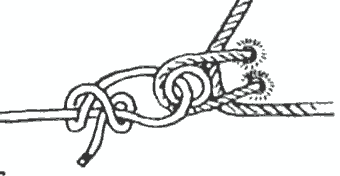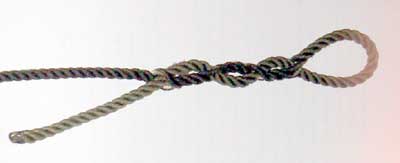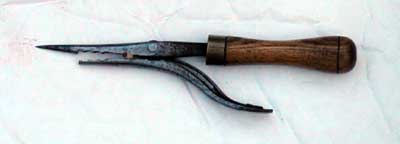Running Rigging
Efficient setting of a gunter, or a gaff mainsail,
demands the use of a two halliard system. The throat halliard
has a two-part purchase, as outlined in the previous column.
This enables a tight luff to be achieved. A little slack in
the luff lacing at the throat allows the halliard to give a
tight luff right along the yard to the peak, by pushing the
yard up tight.
The proper way to set up a gunter sail, is to
hoist the sail with the yard more or less horizontal, until
the luff is fairly tight. Then pull up the peak into the right
attitude. Swig up the throat halliard very tight and belay,
and finally set the peak. The turk’s head on the span
forms a stopper about a third of the way from the jaws end,
and permits a fair lead for the peak halliard. Otherwise the
span shackle would pull hard up towards the mast, and make for
heavy hauling. Alternatively lash the span tight against the
yard with two or three turns of small line. This is also beneficial
if the span is so slack as to make the peaking up of the sail
impossible.
It is one of the advantages of the gaff or gunter
rig, that the sail can be lowered when the craft is not luffed
up head to wind. It is advisable to employ twin topping lifts,
in order to control the yard when lowering. They may be rigged
as one continuous line from the masthead to a block at the end
of the boom, back up to a block at the masthead, and then down
to a cleat. However, I found it better to use two separate lifts,
from the boom end, up to small cheek blocks on either side of
the mast and down to small cleats on the gunwales just aft of
the shrouds, one each side. If the topping lifts are made from
good line of at least 1/4ins dia, they may very well serve as
spare halliards in an emergency. The need for twin lifts is
that they gather up the sail when lowering, and prevent it from
going into the sea. This particular attribute may be usefully
improved by the addition of a lazyjack passing under the boom
and making fast to the lifts about halfway up each. A boat rigged
as described might seem to use a lot of line, but each piece
has a useful role, and makes for efficiency in sailing.
A boat need not be a mess of ironwork. It is
better, and cheaper, to use a hitch or tie instead of a shackle
for many purposes, such as halliard to jib.
The mainsheet warrants care and thought in its
arrangement. The mainsail of the Oyster is 113 square feet,
and a two-part purchase is sufficient for winds up to force
three, but when the wind gets up to F4 or more, then 3:1 is
more comfortable. This can be arranged by the use of a double-ended
mainsheet. From a cleat on one side of the cockpit area the
sheet passes round a block on the quarter, up to a becketed
block at the end of the boom, down to the other quarter block
and then the tail finally to hand or a cleat. This gives the
2:1 purchase. When the wind gets up, the shorter end is removed
from the cleat and made fast to the becket on the boom end block,
using a buntline hitch, or any other suitable knot or tie, thus
giving a 3:1 advantage.

Buntline Hitch
The foresail, too, must be set with a tight luff
for efficient sailing on the wind, and a good way of using a
3:1 halliard purchase obviates the need for a tack downhaul.
The end of the halliard is hitched to the head of the jib, or
perhaps the upper swivel of the furling gear, and passed round
the block at the masthead, then down to about a foot from the
cleat or belaying pin, where it is attached to the top of a
small becketed block. From the becket a length of a lighter
line comes down to hand. The tail is passed round the belaying
pin, or cleat, back through the block, hauled down and made
fast. It will be apparent that a snatch block would be the more
elegant method, but any small block could be used, by having
the length of the tail passed round the sheave, pulled tight
and then, when hauled down, the loop is passed round the belaying
pin, and hauled up using the tail. There you have it…a
3:1 purchase, which on my boat is sufficient to bend the mast.
It is not necessary to use a shackle for attaching
the sheets to the clew of the jib. A cheaper, lighter and possibly
less painful way is to make up a short line of small stuff with
a turk’s head at one end, and a spliced loop at the other.
This is hitched to the middle of the rope used for the jib sheets.
The loop is passed through the eye in the clew of the sail and
is secured by putting the turk’s head through the loop.
If the lengths are carefully arranged, no amount of flogging
can dislodge it, and it is instantly put on or taken off. It
is also kinder to the crew when it strikes the side of the head.
The jibsheet fairleads are mounted about a foot inboard, on
my Oyster. Many tubby cruisers have their fairleads far too
far from the centre line for sailing close to the wind.
All my halliards are made fast to belaying pins
through the mast thwart. They are spaced out fairly well so
that they provide extra staying for the mast.
A tallow box is a good thing to have on any boat.
Mine is made of wood and it is in constant use for the greasing
of shackle pins, and dressing the leather lining of the gaff
jaws.
It is not necessary to buy expensive blocks made
of stainless steel or plastic etc, when common unstropped wooden
blocks are available. I used to buy ex-WD blocks from a firm
called Thomas Foulkes at a very cheap price, by the dozen, and
strops are very easily made up.
To make a strop you will need a piece of rope
that will fit nicely in the groove of the block and about three
and a half times the length needed to go round the block and
the thimble. One thimble is needed for an ordinary block, and
two for a becketed one.
Unlay the rope into its three separate strands,
and, taking one of the strands, tie a simple overhand knot and
pull it tight to about the size desired. If the kinks in the
rope cause the knot to lie tidily in the grooves, then all is
well. If it will not pull down tidily (tiddly) then undo it
and retie it the other way. Then, having pulled the loop down
to the right size, you simply take one end of the piece and
lay it up back into the lay until only an inch or so is left,
and then do the same with the other end. All that remains is
to tuck the ends in, as on a simple splice as neatly as possible;
put the rope ring onto the block, add the thimble (s) and a
tight whipping is clapped on. This is a very satisfying task,
and is much better than watching television. A stropped block
with a long tail is every bit as effective as an expensive swivel
block for many applications on a boat.
A similar method may be used to put an eyesplice
into a rope. Unlay one strand only to the desired length, and
taking the single strand in one hand, and the double in the
other, tie a simple overhand knot, right over left, and pull
down to the required size. Then lay up first the single strand,
and then the double, until the eye is completed. The tails are
tucked in the usual manner. And I would wager that the finished
job is less likely to pull out, than an ordinary eye splice.
The Dutch, in general, are very able seamen, and
it is said that they can sometimes be considered a trifle parsimonious.
That is perhaps unfair, but one of their ploys deserves a mention.
To splice an eye in a rope necessarily uses (wastes) a bit of
length. The Dutch use a simple tuck splice that does not involve
unlaying the rope at all. It is easily and quickly made, very
secure, and readily undone to leave the rope at the original
length. The rope is looped round to the wanted size, either
a soft loop or round a thimble, and the tail is tucked under
one strand, then a second, and then a third. All different strands,
of course, with each tuck a short distance from the next. Perhaps
a fourth tuck would be desirable with hard synthetic rope. As
a matter of interest I put a common splice into one end of a
six foot piece of polypropylene line, and a Dutch splice into
the other. I then fastened one end to an immovable object and
the other to the towbar of a Landrover, and tested it to destruction.
The common splice pulled out after the line stretched to twice
the length.

a simple Dutch tuck splice
My tiller is made from the shaft of a large felling
axe, which is quite shapely, and is made from ash wood. I cut
a large notch in the forward end of it, which enables a length
of shock cord, loosely rigged between the two quarter knees,
to be hauled out, dropped into the notch, thus holding the helm
steady. Useful when sailing single-handed.
To assist in rope splicing, a hollow fid is very
useful, and I have also made use of an old gadget which was
originally made for carpet pegging. It is a wood handle with
a spike at the end, with a trigger which opens a jaw. The effect
is rather like a pair of long-jawed pliers with a spring to
keep the jaws closed. They were in common usein the early part
of the last century, in the North of England, where I live.

Splicer
Next Month: Sails


